Crawling Back: Amazing Spider-Man #26-27 Review (The Osborn Prelude, Part 4)
This two-parter concocts an engaging mystery surrounding notions of identity and diving into the masks our central characters wear
—by Nathan on December 29, 2023—
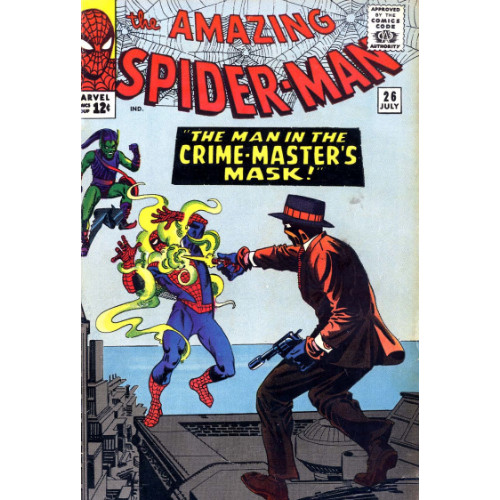
"If you dig an action-packed old-fashioned cops'n'robbers mystery yarn, this one is for you!" a blurb on the splash panel of Amazing Spider-Man #27 crows. Quite the sentiment, especially when paired with the closing narration in the previous issue promising "one of the greatest battle royals of all!" Stan Lee, known for his frequent hyperbolization, was sure a master at drumming up hype for his stories. Who wouldn't want to slam back an issue or two dedicated to gangsters and Goblins?
Rest assured are the wary, however: "Even if you don't like this kind of story," ASM #27 continues, "read it anyway! It may just change your mind!" Well, thank goodness for that. I was getting a little worried for a second. I mean, if you made it through Part 1 of this two-part epic, regardless of whether the experience was seamless or a struggle, you may as well stay for the second half!
The long-running mystery surrounding the first Green Goblin develops further in this two-issue tale, and as we continue peeling back the layers between the grotesque gargoyle's grinning green mask and his fleshy face, we come across an engaging story that exemplifies what the Goblin's original narrative could have been if certain rumors were actually true.
"The Mystery of the Man in the Crime-Master’s Mask"/"Bring Back My Goblin To Me"
Writer: Stan Lee
Penciler: Steve Ditko
Inker: Steve Ditko
Colorist: Stan Goldberg
Letterer: Sam Rosen
Issue: Amazing Spider-Man #26-27
Issue Publication Dates: July-August 1965
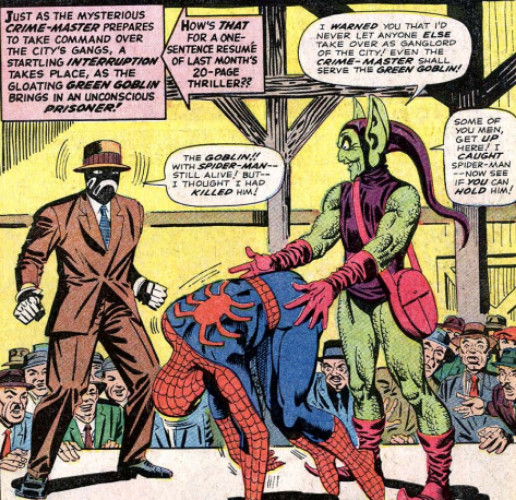
This is a story of men who wear masks.
That doesn't feel like anything new, right? Most folks in capes and tights hide their faces behind a mask of some kind. Maybe it's a domino mask like what Bucky or Robin wear, or a mask that covers most of a hero's face, or a mask that covers the whole head. It hides the face, obscures the features, maybe muffles the voice. Some folks go in the opposite direction: their real face is the mask. Look at how Superman can slap a pair of glasses over his eyes and–presto!–he's suddenly a mild-mannered reporter working for the Daily Planet. And then you've got weirdos like the Fantastic Four who just say "screw it" to the whole secret identity thing, but we're not talking about them.
We're talking about the men who wear masks.
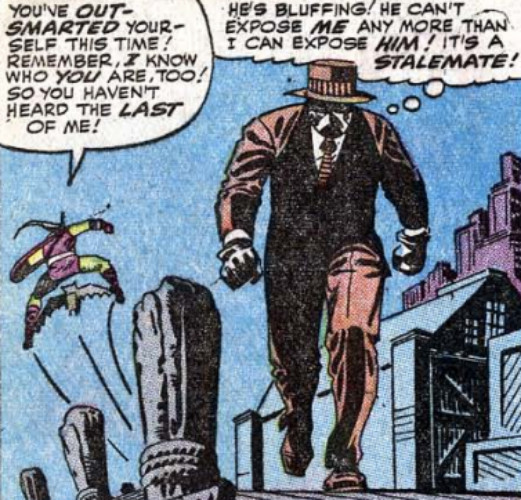
It wouldn't necessarily be an important detail, except for the fact that it comes up so often across this two-issue tale. Spider-Man wears a mask, as does the Green Goblin, new adversary the Crime-Master, and a police informer named "Patch." Patch is called Patch because he wears an eyepatch, see, which is part of a larger mask covering his entire face, because I'm pretty that if he just went with the eyepatch, people would recognize him (which makes me wonder: could Clark Kent fool people by just wearing an eyepatch?). I don't know if the mask aspect was intentionally planted by Lee and Ditko, but the notion of "masks," both physical and metaphorical, in how they shape and obscure one's identity, becomes a surprising theme across this story.
We are, as I alluded to in the opening, in the midst of a major Marvel mystery: who is the Green Goblin? Longtime readers know the answer to that inquiry, but in 1965, the Rubik's Cube of the Goblin's true self was still a confused cuboid of colors, slowly spinning into proper alignment. The Goblin's last appearance, where he first tried gaining control of New York's criminal underworld, did very little to address or deepen the mystery. Here, we learn a very important piece of info: the Crime-Master knows the villain's true identity, and vice versa. Each man uses the threat of blackmail to keep the other in line, causing a stalemate between them as they vie for the whole evil enchilada.
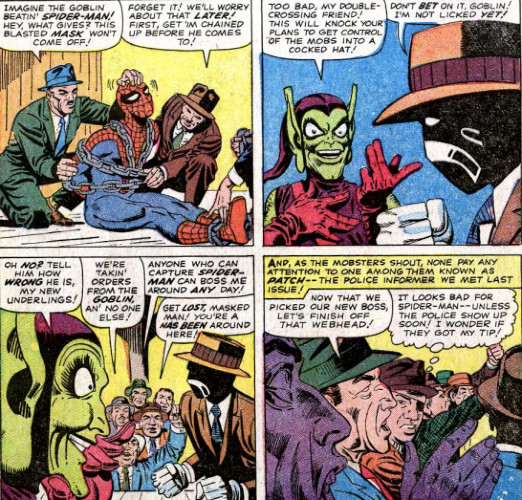
Though the Crime-Master takes center stage, his secret identity duels with the Goblin's as Spidey digs into the mystery. Can our hero finally pin down just who these men are? Lee and Ditko provide enough "oomph" to the mystery surrounding the Crime-Master to keep you guessing, even if suspects are few. They alight on one individual in particular, Frederick Foswell, keeping your attention by throwing in enough clever clues to make you assume you know where this is going. Foswell's prior criminal career as the Big Man, a scene where he changes out of the clothes of a mysterious alter ego he's assumed, and an attack on Spider-Man by the Crime-Master while Spidey cases Foswell's apartment all lead you to make the obvious conclusion.
Spoilers for a 58-year-old comic, but you'd be wrong.
The Crime-Master, as it turns out, is a nobody. At least, nobody we've been previously introduced to. When, as the second issue crescendos, it's revealed the Crime-Master is mobster Nick "Lucky" Lewis, a thug we've never met whose face is never physically seen, you initially feel cheated. Lee and Ditko have spent these issues building this dude up–he trounces Spider-Man in the first issue, double-crosses the Green Goblin, stakes his claim as head honcho of the underworld…and he's just some guy? It's kinda funny, Spidey thinks when he hears the news, in real life, when a villain is unmasked, he isn't always the butler, or the one you suspected! Sometimes, he's a man you didn't even know!
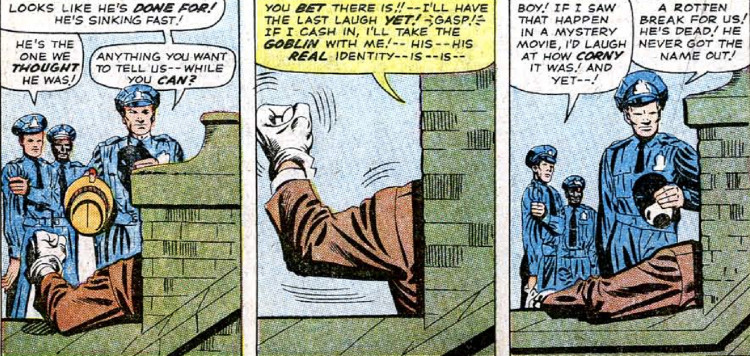
And that’s the whole point, isn't it?
I remember feeling disappointed when I first read this issue as a kid some 16-to-17 years ago. The revelation was a letdown…it didn't feel like a revelation at all! A non-twist! But reading this again, I realize, what did I expect? If not Foswell, who else could've filled the Crime-Master shoes? J. Jonah Jameson? Flash Thompson? Betty Brant?? Aunt May??? No previously introduced character fit the bill for the criminal mastermind, and at this point, my disappointment has transformed into respect. It's a gutsy move Lee and Ditko make, wildly subverting your expectations. Spidey's assessment is right: not everything is so clean in real life, pre-packaged for the greatest emotional gut punch you can deliver, like in a story. Yes, several clues point to Foswell, but as the story wraps up, we realize those clues take us in a different direction regarding the former criminal, a twist delivered on the final page showcasing Foswell's true intentions.
I don't know whether Lee or Ditko decided on the Crime-Master's identity, but as Ditko is also credited as the story's plotter, I could see it being him. If Ditko is responsible for assigning a blank canvas like "Lucky" Lewis the Crime-Master's cowl, the move feels like a defense of another (rumored) idea of his: making the Green Goblin's true identity a nobody.

I've dug into this a little bit recently. The long-running rumor associated with the Goblin's development is that Ditko wanted the Goblin to be a regular Joe not previously connected to Spidey lore while Lee pushed for someone with more historical heft in the title. That "rumor" is generally attributed to Lee, while Ditko's account differs–he claimed to intentionally plant Norman Osborn in several scenes before his reveal as the Goblin, always intending this background character to be the man behind the mask. Yes, Osborn lingers in the background in these issues, appearing in a couple panels with Jameson at a club. He's not established as an actual character here, but if we look closely, we can see the clues. I feel more hesitant to fully trust Lee over Ditko, and given that the "bad guy is nobody we know" trope had been previously used (with Electro, Mysterio, and now the Crime-Master), I feel a little more confident in saying Ditko didn’t want to re-hash the same trick with the Goblin. Lee's arguments against Ditko may just be "The Man" taking some additional credit for an idea which wasn’t wholly his, as he was wont to do.
But I digress.
From a historical point of view, turning the Green Goblin into a faceless, nameless goon would've wounded the character's status, but that's something I'll touch on more in the next post. For these issues, you may wonder why a businessman like Norman Osborn would deal with a thug like the Crime-Master, or why he'd seek control over the mobs at all, but the impetus in this issue comes from the rivalry developed between the two villains. The Goblin does want control over the mobs, but now, he has a genuine rival and feels more driven precisely because someone else wants what he wants. Even a brief partnership between the men fails when the Crime-Master turns on the Goblin. There's an "If I can have it, nobody can" mentality the Goblin employs that points to a deeper desire for total domination. Dude's a control freak. As a result, his enmity with Spider is somewhat sidelined, and though they trade some blows in a larger brawl involving cops and robbers, their only one-on-one confrontation is a one-sided battle where the Goblin trounces Spidey shortly after the Crime-Master nearly kills the Web-Head. Not a good day for our harrowing hero.

I criticized the "Green Goblin as mob leader" in my previous post as an odd direction to take the villain. At that point, it certainly didn’t seem like the Goblin was the arch-foe we know him as today (that status doesn’t seem to develop, or begin developing, until ASM #39-40, which I'll examine in the next "Osborn Prelude" post). This two-issue tale seems to make it a tad clearer that the Goblin really is a power-hungry goon–having humiliated Spidey several issues ago, he's moved onto bigger, better, and badder plans. Again, why a businessman chooses to get in league with the New York underworld is anyone's guess. But the plot does point to those personality traits, crafting this double-dealing, power-grabbing gargoyle who won't back down, take "no" for an answer, and gleefully backstab anyone who thinks they can get in his way. We begin seeing more of the Goblin come out, we watch as he develops a personality which deepens his character beyond the mystery behind his mask.
For Peter Parker, the mask continually represents who he is as a hero, even when he isn't wearing it. As this story opens, Peter's recently ditched his costume to escape the clutches of JJJ and worries over finding new threads. He purchases a costume from a shop, finding it ill-fitting as he swings through the city. It's another example of the ever-endearing trope of having nothing work out right for the character, with just enough charm to make the inconvenience somewhat humorous rather than downright frustrating for the reader. You may also point to the costume as a symbol of how the role of Spider-Man is "ill-fitting" for Peter as well, a role he's dedicated to yet struggles to fill, especially when it collides with his personal life. But for a while, Peter's a Spider-Man without a costume, and it allows us to see more of Peter Parker. We watch him get into an argument with Betty Brant, engage Flash and his friends in an actual fistfight, and on the quieter end, take Aunt May out to see a movie.
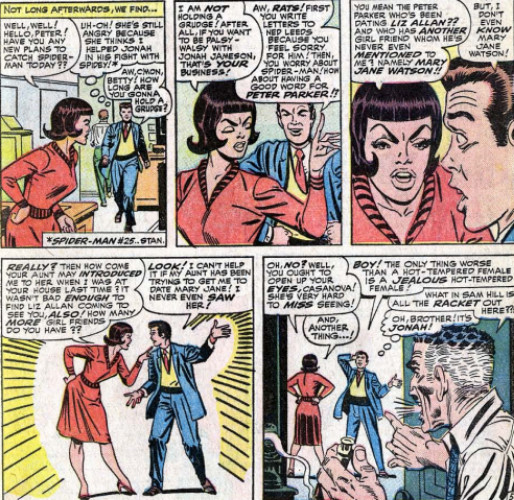
I appreciate Lee and Ditko giving Peter room to breathe in these issues, for the moments where the young man breaks free from the stereotypical mold society has constructed around him. Not that we want to condone a schoolyard brawl, but this is a Peter Parker who put up with so much taunting previously who finally, for just a moment, shows he's got some spine even when he's not swinging around New York. And not that we want to condone a shouting match in the middle of one's workplace over romantic entanglements, but at least Peter is given the opportunity to stand up for himself, particularly when other issues don't allow the Peter/Betty relationship to gain any traction. The bit with Aunt May is just a delightful cherry on top, showing us the consistent love Peter has for the woman who raised him. He even blames his Spidey activities on why he's neglected her recently, momentarily reflecting on the bizarre blurring between his personas. In moments, it seems, our hero can't divide his identities as cleanly as he would like, letting his anger get the best of him in a sudden show of strength he fears could've "exposed [himself] as Spider-Man!" In a story predicated on identity, Lee and Ditko masterfully weave in some conflict with Peter's dueling personas.
As I said, this is a story of men who wear masks. Oftentimes, those masks are literal. The Crime-Master and Green Goblin hide their identities from their enemies, discovering that revealing their true selves to each other creates tension instead of trust. Peter Parker discovers the inherent danger in letting his two selves collide when a bitter Spider-Man temporarily takes hold of his actions. Even Frederick Foswell places himself in a world of danger as he assumes a different identity, and even if Spidey's assumption that he's taken up crime again is wrong, the reporter brushes up against the underworld in a way that makes you wonder if he'll be killed for his subterfuge…or lured back to a life of crime.
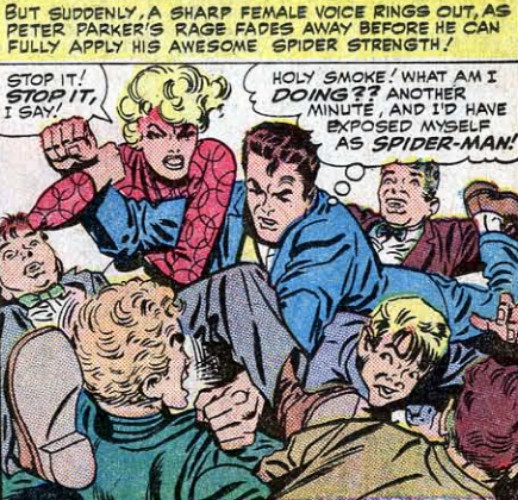
Once again, the Green Goblin fails to win over the New York underworld. That’s okay. His direction and intentions shift next time we see him. So far, we've been teased with who the villain is, a concept seemingly bantered between his two creators. Regardless of the truth, his next appearance seals the deal, and it's this startling two-issue saga which cements (I believe) the Goblin/Spidey rivalry for the next fifty-odd years.